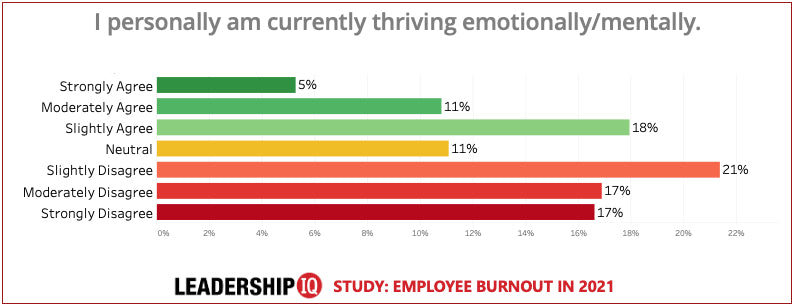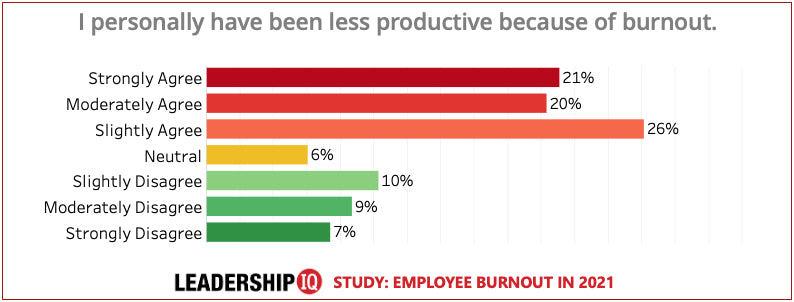Employee Burnout In 2021
Leadership IQ surveyed 4,913 leaders and discovered that employee burnout is causing lost productivity, more mistakes, employee turnover, decreased optimism, lowered resilience, and more...
In 2021, companies face an employee burnout crisis. Employee burnout (aka job burnout) is chronic workplace stress that causes exhaustion, reduces optimism and resilience, increases mistakes, causes lost productivity, and ultimately increases employee turnover. A new study reveals key effects of employee burnout as well as discovering critical steps for reducing and preventing employee burnout. Here are some highlights from this study...
- Only 25% of leaders feel that their employees are thriving emotionally and mentally
- 79% of leaders have seen less productivity as a result of employee burnout
- 75% of leaders agree that their people are making mistakes as a result of employee burnout
- 84% of leaders have heard their employees use language indicating burnout
- Only 24% of leaders say their company conducts training that effectively reduces employee burnout
- 71% of leaders expect that high performers are going to quit because of employee burnout
- The early morning hours (between 6AM-10AM) are by far the most desired times for working without interruptions
- Fridays and Mondays were by far the most desired days for working remotely
- Only 19% of leaders feel that they really know how to reduce employee burnout
STUDY METHODOLOGY
Leadership IQ surveyed 4,913 leaders in the United States during the week of August 9, 2021. Respondents answered 18 questions about various dimensions of employee burnout, including emotional wellness, employee turnover, workplace interruptions, desired days for remote working, and more. Respondents represented the following demographics. POSITION: Top Level Executive (12%), Senior Vice President (12%), Vice President (14%), Director (26%), Manager (36%). The margin of error is plus or minus 2 percentage points.
FINDING #1: ONLY A QUARTER OF LEADERS FEEL THAT THEIR EMPLOYEES ARE CURRENTLY THRIVING EMOTIONALLY & MENTALLY
Employees who are thriving emotionally and mentally are, by definition, NOT experiencing employee burnout. That's why it's so troubling that only 25% of leaders feel that their employees are thriving emotionally and mentally right now. As you can see in the chart below, 57% of leaders disagree that their employees are thriving. Another 19% of leaders don't necessarily see their people experiencing employee burnout signs but neither do they see them thriving emotionally and mentally. When staff burnout is so obvious to leaders that they can see that their employees are NOT thriving, it's virtually assured that there will be deleterious effects on employees' mental health, productivity, job satisfaction, turnover, and more.

FINDING #2: ONLY ABOUT A THIRD OF LEADERS ARE CURRENTLY THRIVING EMOTIONALLY & MENTALLY
Companies often expect that leaders are immune to employee burnout. Yet the data from this study shows that only 34% of leaders are themselves thriving emotionally and mentally. By contrast, 55% of leaders disagree that they're thriving. It's incredibly difficult for a manager to mitigate burnout risk for their employees when they themselves are experiencing employee burnout (and feel like their mental health and emotional wellness are suffering). It's certainly not unusual for leaders to experience burnout (in fact, some studies have even found that increased pressure at work can reduce executives' life expectancy). But if companies are serious about reducing employee burnout, they will need to also directly address burnout symptoms for leaders.

FINDING #3: more than three-quarters of leaders have seen employee burnout reduce productivity
It stands to reason that when an employee feels intense stress, their work will suffer. One specific way that employees' work will suffer is via decreased productivity. Being highly productive requires a kind of focus and mental discipline that is tough to maintain when one is experiencing emotional exhaustion. And as you can see in the chart below, 79% of leaders have seen their people be less productive as a result of employee burnout.

FINDING #4: TWO-THIRDS OF LEADERS HAVE THEMSELVES EXPERIENCED LOST PRODUCTIVITY AS A RESULT OF JOB BURNOUT
As we saw in Finding #2, leaders are suffering from workplace burnout nearly as much as the typical employee. So it stands to reason that they will experience nearly as much decreased productivity as any worker. As you can see in the chart below, 67% of leaders agree that they have personally have been less productive because of burnout. By contrast, only 26% of leaders disagree that worker burnout has caused lost productivity.

FINDING #5: THREE-QUARTERS OF LEADERS HAVE SEEN THEIR EMPLOYEES MAKE MISTAKES DUE TO STAFF BURNOUT
Whether it's from excessive stress, emotional exhaustion, unreasonable deadlines, etc., the chronic stress of burnout will inevitably lead to an increase in mistakes. And as you can see in the chart below, 75% of leaders agree that their people are making mistakes as a result of employee burnout. By contrast, only 14% of leaders disagree that employee burnout is causing mistakes in their work. The damage from work mistakes will be further compounded when the typical workload is increasing, let alone if employees begin to perceive that they're enduring an unmanageable workload.

FINDING #6: NEARLY TWO-THIRDS OF LEADERS HAVE PERSONALLY MADE MISTAKES AS A RESULT OF JOB BURNOUT
Leaders have not seen quite the same increase in their own mistakes as they've seen amongst the typical employee group, but their admission of burnout-related mistakes is still deeply troubling. An under-discussed aspect of an employee making mistakes because of burnout is that these mistakes can eventually lead to decreased confidence. This decreased confidence, in turn, damages employee satisfaction and ultimately worsens employee wellbeing. It's difficult for an employee or leader to stay motivated and engaged when they see their work mistakes increasing, and they feel unable to reverse that trend.

FINDING #7: EIGHT OF TEN LEADERS HAVE HEARD THEIR EMPLOYEES USE LANGUAGE INDICATING BURNOUT SYMPTOMS
It doesn't take a team of seasoned hr leaders to pinpoint when an employer has burned out employees. In fact, there are specific words that indicate when a company has an employee burnout crisis. Whether the specific words used are tired, exhausted, fried, or burned out, there is a clearly identifiable lexicon that an employee uses when their burnout risk is entering dangerous territory. And as you can see in the chart below, 84% of leaders have heard their employees use language indicating burnout (e.g., burned out, fried, exhausted, etc.).

FINDING #8: THESE ARE THE MOST COMMONLY USED WORDS FOR EXPRESSING BURNOUT
In order to better identify and prevent employee burnout, leaders and hr professionals need to listen acutely to employees' words. This study asked leaders to identify the words that they hear people use most frequently to describe employee burnout. The word cloud below shows which words get used most frequently. This is not an exhaustive list, of course, and an employee could express their burnout quite differently. For example, an employee might express that they're struggling to maintain a healthy work life balance. Or they might say they're receiving unfair treatment. Or they might ask their manager for urgent directions on how to access the employee assistance program. All of those words and phrases are clues to worker burnout. But as a starting point, the word cloud below will give managers and hr professionals words to watch for.

FINDING #9: THE VAST MAJORITY OF COMPANIES ARE NOT CONDUCTING TRAINING TO REDUCE EMPLOYEE BURNOUT
While every company works on employee engagement or has an employee wellness program, it turns out that very few are offering any training (let alone effective training) to prevent or reduce employee burnout. The chart below shows the disturbing finding that only 24% of leaders say their company conducts training for employees that effectively reduces their burnout. To stop the employee burnout crisis, this should be a top priority for every organization. And on the list of possible burnout prevention interventions, training is one of the least expensive and highest ROI activities.

FINDING #10: MORE THAN HALF OF PEOPLE HAVE EXPERIENCED A DROP IN THEIR OPTIMISM AS A RESULT OF THE PANDEMIC
A key aspect of burnout is a loss of optimism. And as you can see in the chart below, 52% of people are less optimistic now than they were before the pandemic. And only 13% are more optimistic.

FINDING #11: ONLY A THIRD OF PEOPLE ARE MORE RESILIENT NOW THAN THEY WERE BEFORE THE PANDEMIC
Not only does worker burnout reduce optimism, it also reduces resilience (i.e., someone's ability to bounce back quickly from hardship). The chart below shows that 43% of people are less resilient now than they were before the pandemic, while only 34% are more resilient.

FINDING #12: NEARLY THREE-QUARTERS OF LEADERS BELIEVE THAT HIGH PERFORMERS WILL QUIT BECAUSE OF BURNOUT
A burned out employee is a less engaged employee, and a less engaged employee is far more likely to quit. You can see in the chart below that the majority of leaders believe that job burnout and a less engaging work environment is going to lead to employees quitting. And what's especially troubling about this data is that leaders expect that high performers (aka the best employees) are going to quit from burnout.

FINDING #13: ONE BURNOUT PREVENTION TECHNIQUE IS TO GIVE PEOPLE UNDISTURBED TIME FOR DEEP THINKING
Much has been written about how constant interruptions not only damage productivity but can also create chronic workplace stress. And this is true for both people in the office and remote employees. So we asked study participants to identify the times of day they would most like to be undisturbed, so they can accomplish deep thinking, creating, writing, etc. You can see in the chart below that the early morning hours (between 6AM-10AM) are by far the most desired times for working without interruptions. Even if your workplace culture likes its early morning meetings, you may want to strongly reconsider that approach in light of this new data.

FINDING #14: FRIDAYS AND MONDAYS ARE THE MOST DESIRED DAYS FOR WORKING REMOTELY
Another approach for preventing job burnout is to allow people a bit more flexibility to function as remote workers or work from home. But far too many companies are arbitrarily decided for their employees which days are acceptable for remote work. We asked leaders to identify which days they would most like to work remotely, and as you can see, Fridays and Mondays were by far the most desired days.

FINDING #15: ONLY 19% OF LEADERS FEEL THEY REALLY KNOW HOW TO REDUCE EMPLOYEE BURNOUT
In a separate study, we asked leaders to rate their level of expertise with performing certain leadership skills. When it comes to reducing employee burnout, only 19% of leaders rated themselves as expert or advanced. In other words, most leaders readily admit that they don't have the skills to tackle employee burnout issues.

MEDIA INQUIRIES:
For media inquiries about this study, including to interview Mark Murphy, CEO of Leadership IQ, please contact media@leadershipiq.com
Related Posts
- Leadership Styles Quiz: Which Of These Different Leadership Styles Do You Use?
- Communication Styles Quiz And Research: Which Of These Different Communication Styles Do You Use?
- Types Of Power Quiz: Do You Use Referent Power, Reward Power, Coercive Power, Legitimate Power, Expert Power or Information Power?
- Quiz: What Motivates You?
- The State Of Leadership Development
- Why New Hires Fail (The Landmark "Hiring For Attitude" Study Updated With New Data)
- Are SMART Goals Dumb?
- Employee Engagement Is Higher For Low Performers In 42% Of Companies
- Quiz: What's Your Organizational Culture?





